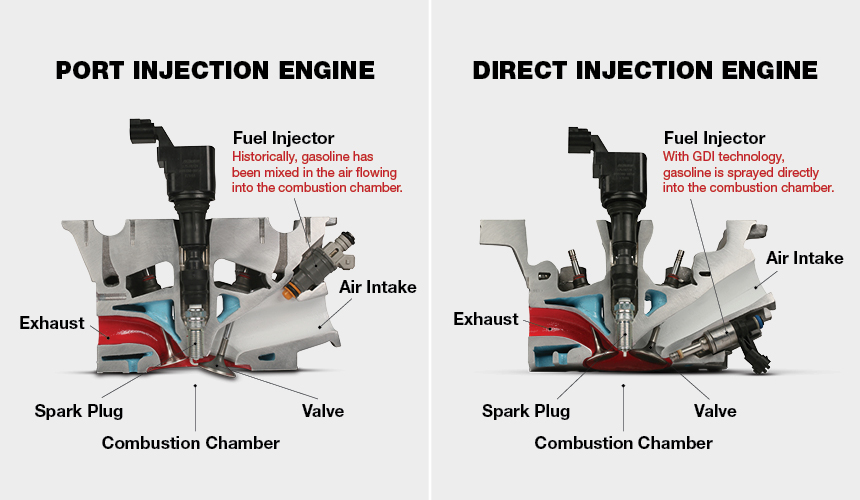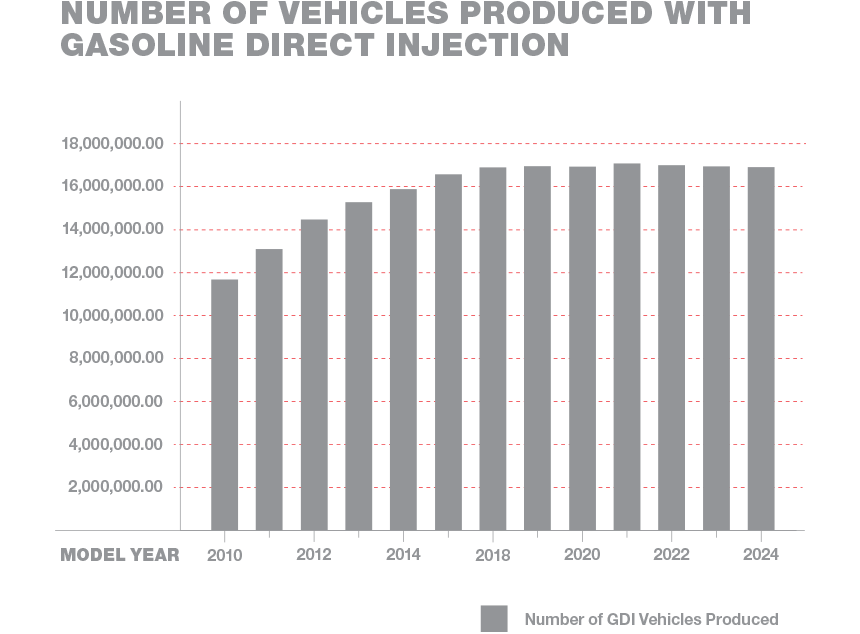The implementation of the next ILSAC engine oil service category for passenger cars, ILSAC GF-6, has been delayed. This delay has pushed Original Equipment Manufacturers (OEMs) that produce vehicles powered by gasoline direct injection engines (GDI), to look for an interim solution to the challenges presented by GDI technology. That solution? SN Plus.
Why is SN Plus Needed Now?
GDI technology coupled with volumetric efficiency improvers, such as turbochargers and superchargers, results in improved engine efficiency and decreased fuel usage. However, these technologies have resulted in a condition known as low-speed pre-ignition (LSPI). LSPI is a premature ignition of the air-fuel mixture in the combustion chamber. Other terms used for LSPI include “super knock,” “mega knock,” and stochastic pre-ignition. Over the past seven years, vehicles have been increasingly experiencing LSPI. Vehicle manufacturers need a solution to the problem.
Why Gasoline Direct Injection?

Historically, gasoline has been mixed or injected in the air flowing into the combustion chamber. While these methods have worked well over the past 100 years, it is not the most efficient means of fuel delivery. With GDI technology, gasoline is sprayed directly into the combustion chamber under high pressure, often times 2000 psi or greater, atomizing fuel molecules to become very fine droplets. This allows for improved mixing of fuel with the incoming charge of air. This improved mixing results in increased efficiency of the engine and decreases the total amount of fuel used in the combustion process. This translates to more power from a smaller-displacement engine and improved fuel economy for the vehicle.
Understanding LSPI
The low speed in LSPI (which refers to the speed of the engine, not the speed of the vehicle) occurs in the 1200 to 2700 rpm range. This low speed pre-ignition is very violent and causes over pressurization of the combustion chamber that can lead to damage and failure of the piston, rings, valves, and other internal components.
During LSPI testing, pressures as high as 1595 psi were observed in the combustion chamber. Normal combustion in this test yields a maximum pressure of 623 psi. That is a spike of 256% in pressure!
Understanding How GDI + Turbocharging Increases the Likelihood of LSPI
In addition to GDI, turbocharging is another tool to improve engine efficiency and fuel usage. Turbocharging is sometimes referred to as a volumetric efficiency improver. Adding a volumetric efficiency increaser packs more air into the cylinder, resulting in smaller engines making more power and torque. Frequently turbocharging is coupled with GDI. By harnessing these two technologies, OEMs can use 6-cylinder engines where 8-cylinder engines were necessary in the past. Additionally, 4-cylinder engines using GDI and turbocharging have become the new normal for power and efficiency in many small to mid-size cars and SUVs. Frequently, the combination of these technologies is abbreviated TGDI (Turbocharged Gasoline Direct Injection). While there are many benefits to combining these technologies, it also creates the perfect storm for LSPI.
OEMs Asked Engine Oil Manufactures to Reduce LSPI by Optimizing Engine Oil Formulations
Using a SN Plus chemistry engine oil in any GDI or TGDI engine will reduce the likelihood of LSPI.
General Motors included a LSPI test in the dexos1:2015 specification which is marketed as dexos1® Gen2. Other OEMs have issued new specifications including LSPI protection as well.
Testing of engine oils for LSPI tendencies has shown that calcium-based detergents increase the likelihood of a LSPI event. The removal of all calcium-based detergent is neither economical nor practical. The approach of a hybrid detergent package is the most economical and practical solution. A typical hybrid detergent package may contain lower calcium while increasing the level of magnesium-based detergent. By taking this hybrid approach, engine oil manufacturers are able to achieve an economical solution to a complex problem.
The Easiest Solution for Your Customer is to Switch to SN Plus Now, GF-6 Later
LSPI is a very real challenge that must be addressed with proper engine oil formulations as well as mechanical and engine management software design considerations. The easiest solution is to use a SN Plus engine oil with an optimized detergent system. This reduces the chance of a LSPI event by keeping engine components clean and free of deposits as well as lowering the possibility of auto-ignition.
Opportunities
Starting in 2010 and looking ahead to 2023, we see a market dominated with gasoline direct injection engines. While not all are turbocharged, the majority of GDI engines are. This presents a great opportunity to educate the public on motor oil’s importance in preventing LSPI.

SN Plus FAQs
Q. What is SN Plus passenger car automotive specification?
A. The Lubricants industry is currently developing a supplemental specification for ILSAC GF-5/API SN. The formal name for this category has yet to be determined but most are referring to the supplemental category as SN Plus. If enacted, SN Plus will be a licensed category providing additional benefits above current GF-5 products. The primary additional benefit will be protection against low-speed pre-ignition, commonly known as LSPI.
Q. What is driving this category update?
A. ILSAC (International Lubricants Standardization and Approval Committee, or the collection of automotive original equipment manufacturers (OEMs), have formally petitioned the API (American Petroleum Institute). Due to delays in GF-6, OEMs feel that they cannot wait until late 2019 (most current GF-6 launch date) for lubricants that provide protection against LSPI.
Q. Why is this an important update for the industry?
A. This update is important for the lubricants industry because it helps mitigate LSPI and allow OEMs to tune their engines for ultimate efficiency, which ultimately helps OEMs meet government environmental regulations and saves consumers money on fuel. LSPI is commonly associated with turbocharged and direct injection engines (GDI). GDI engines are starting to represent a significant portion of the market, so lubricant suppliers and consumers need a way to know if the oil they are receiving will provide the necessary protection.
Q. How will this affect the launch of GF-6 products?
A. Currently the development of GF-6 will be unchanged with this additional category. A GF-6 category launch is still targeted for late 2019/early 2020 but this timing has already slipped several times.
Q. What is the timing for launch of SN Plus products?
A. ILSAC has petitioned the API for a January 1, 2018 first licensing date. However, there is still significant work to be done to qualify these oils before first license. API has not announced a formal timeline for introduction at this time.
Q. Will API SN/GF-5 oils still be produced?
A. API SN and GF-5 will still be licensable categories, so there will be some API SN & GF-5 oils in the market until the launch of GF-6. That being said, the new interim category will be backwards compatible to GF-5, meaning that any GF-5 application can use SN Plus without loss of performance.
Q. How will this affect my day-to-day business?
A. When SN Plus officially launches, it is expected that some large domestic and foreign OEMs will create new specifications for vehicles utilizing GDI technology. This means that almost overnight, many vehicles previously serviced by GF-5 oils will now require or recommend SN Plus technology. Installers will want to ensure that they have SN Plus oils available or risk losing business to dealerships.
Q. How will this affect my vehicle?
A. If you have a GDI/turbocharged vehicle, you will want to start using SN Plus oils regardless of whether your OEM requires it or not. These oils will provide better protection for your vehicle, helping it run longer and more efficiently.
Q. How should lube shops be preparing for the SN Plus update?
A. Lube shops should have a plan on how to service their customers. Engage with your oil supplier and inquire as to how they plan to service the SN Plus market. This can be accomplished in various ways but your business will need to address the issue.
Q. What is Phillips 66 doing to prepare for the update?
A. Phillips 66 is working closely with OEMs and the API through our long term relationships to be on the leading edge of SN Plus. As the industry finalizes launch timing for SN Plus, Phillips 66 will provide more information on our plan to supply SN Plus oils to the market.









